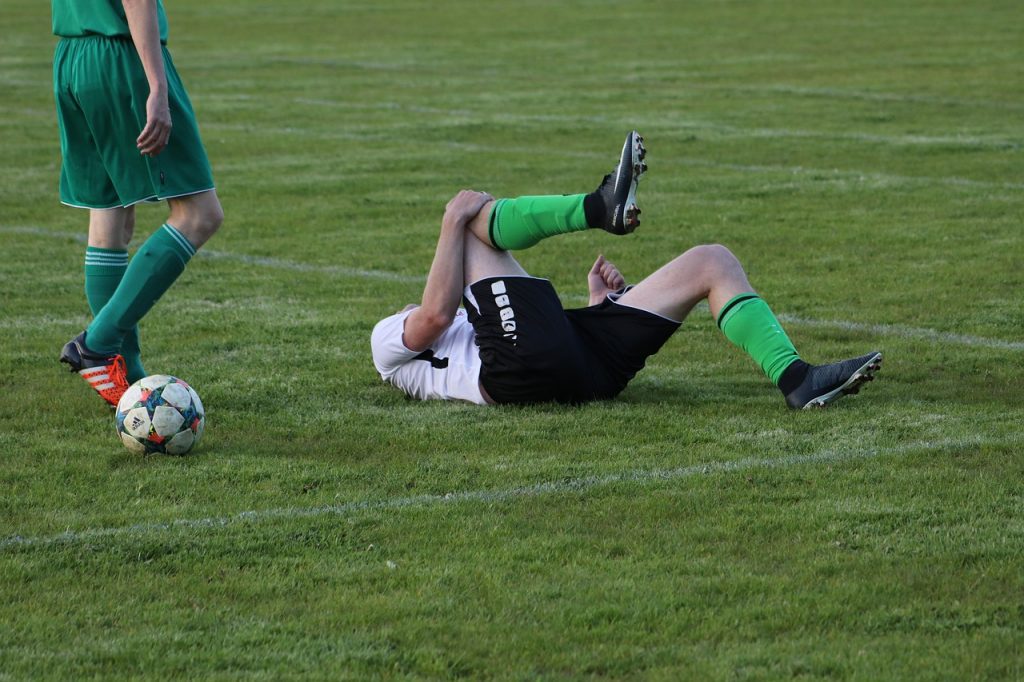Sports are a fun way to stay fit and healthy while making friends, getting outside, and joining a community of people who enjoy what you do.
While participating in sports is fun, the reality is that there is an inherent risk associated with athletics. It’s estimated that there are an average of 8.6 million sports-related injuries each year in the United States. These injuries range from minor to serious with 50 percent of these sports injuries needing professional care.
In this post, we’re going to look at 3 common sports injuries along with their prevention and treatment options so you can stay safe and in the game.
1. Sprained Ankle
Sprains & strains are common sports injuries, with ankle sprains as perhaps the most common type. A sprain is an injury to your ligaments, which are connective tissues that help “attach” bones to other bones to stabilize your joints.
Sprained ankles occur when the ankle rolls inward, for example, usually as a result of running on uneven surfaces or fast lateral movement. This pulls on the ligaments in the ankle, leading to the strain.
Taking extra precaution on athletic fields and uneven surfaces can help you avoid ankle sprains & strains. You should also ensure that you’re wearing the right footwear for the sport that fits your feet perfectly. Dr. Scott can help to determine if the shoes you are wearing fit the sport you are playing.
Sprained ankles tend to be minor, but some (like high ankle sprains) can be more serious. If you’re experiencing pain, FAKTR treatments can be helpful for relieving inflammation and relieving stress on the ligaments and increasing their ability to heal properly. Dr. Scott also gives his patients at home exercises to strengthen the ligaments in the feet to promote healing and prevent re-injury.
2. Knee Injuries
According to a study and review from the Society for Academic Emergency Medicine, the knee is the most commonly injured joint with an estimated 2.5 million sports-related knee injuries occurring each year.
Of these, the two most common are an ACL tear and Patellofemoral Syndrome.
Similar to an ankle sprain, an ACL tear is an injury to a ligament. Your Anterior Cruciate Ligament (ACL) is responsible for stabilizing the knee while you’re walking, running, jumping, etc.
Sudden movements (such as turns, pivots, and sudden changes in movement or momentum) along with excessive use can result in a tear in the ligament itself. This can often happen suddenly accompanied by a popping or tearing sound or feeling.
Serious ACL tears often require surgery along with physical therapy and manual mobilization to heal. Chiropractic manipulations and therapeutic exercises can help with post-surgery recovery and ensure the tissues heal faster and properly.
Want to learn more about at-home recommendations you’ll get from Dr. Scott?
Here’s a quick breakdown of what to expect.
Patellofemoral Syndrome, also called “runner’s knee”, is pain in the lower knee area thought to be caused by overuse and irritation from the kneecap rubbing against the thigh. Other causes include previous injuries, muscular imbalances, and effects post knee surgery.
Increased rest time, running on softer surfaces (like grass instead of cement, for example), proper footwear, and stretching can all help prevent pain and injury.
Chiropractic adjustments along with stretches, exercises, and modalities can help to strengthen the muscles in the leg, reduce risk of injury, and reduce symptoms you might be experiencing. Focusing on strengthening the quadriceps is a great approach to helping deal with PFS.
3. Sciatica
Sciatica refers to a condition marked by lower back pain that radiates throughout the back and oftentimes extends down into the legs. Sciatica can be caused by a few things including disc or facet issues, nerve entrapments and, yes, certain sports can cause excess stress on the sciatic nerve.
Sports that require you to be hunched over and/or flexed in a forward position for extended periods of time, like cycling and golfing, for example, are prone to sciatica and other common sports injuries. You can also get sciatic pain from contact sports like football and rugby.
Because sciatica is more of a symptom than a diagnosis, it’s always best to consult a professional to properly diagnose the true cause of the sciatic symptoms.
Chiropractors are experts in musculoskeletal conditions, making them a great resource for those experiencing sciatica. Dr. Scott puts all patients through a full neurologic and orthopedic exam to determine the cause of the sciatica symptoms and make an appropriate diagnosis.
Combining chiropractic adjustments with FAKTR techniques and targeted exercises can greatly relieve sciatica pain & symptoms. Chiropractic care also works to strengthen the muscles in the spine, which is crucial for avoiding re-injury and stopping long-term damage to the back.
Need Support for Your Sports Injury? Dr. Scott Rosner Can Help
Sports injuries are tough not only because of the discomfort and pain they bring but they also keep you from playing the sport that you’re passionate about!
Get off the sidelines and back into the game by taking control of your healing process. Dr. Scott has years of experience working with athletes of all kinds (from dancers to rugby players) at all levels (from kids to college players to Olympic athletes) to speed up recovery, get results, and get back on the field, the stage, or the court. In addition to his Doctorate of Chiropractic, Dr. Scott has furthered his education by obtaining a Masters in Sports Science and Rehabilitation and earned the designation of a Certified Chiropractic Sports Physician by the American Board of Chiropractic Sports Physicians.
Contact us to set up a consultation or your first appointment.
